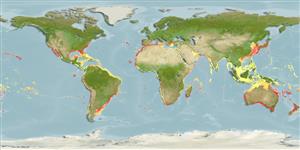>
Carangiformes (Jacks) >
Carangidae (Jacks and pompanos) > Caranginae
Etymology: Pseudocaranx: Greek, pseudes = false + French, carangue, the name of a Caribbean fish; 1836 (Ref. 45335).
More on authors: Bloch & Schneider.
Issue
The species Pseudocaranx cheilio (Snyder, 1904) is considered as valid in Eschmeyer (CofF ver. Mar. 2011: Ref. 86697) following Randall (2007: Ref. 86689). The species Pseudocaranx georgianus (Cuvier, 1833) is considered as valid in CofF ver. May. 2011 following Smith-Vaniz & Jelks (2006: Ref. 76781), with Caranx luna Geoffroy Saint-Hilaire, 1817, Caranx platessa Cuvier, 1833, Caranx nobilis Macleay,1881, and Usacaranx archeyi Griffin, 1932 as synonyms. Caranx georgianus (now under Pseudocaranx is also a valid species.
Environment: milieu / climate zone / depth range / distribution range
Sinh thái học
Biển; Thuộc về nước lợ Cùng sống ở rạn san hô; Mức độ sâu 10 - 238 m (Ref. 58302), usually 10 - 25 m (Ref. 5288). Tropical; 40°N - 47°S
Western Atlantic: North Carolina, USA and Bermuda to southern Brazil. Eastern Atlantic: Mediterranean, Azores, Madeira, the Canary Islands, Cape Verde, Ascension and St. Helena Island. Indo-Pacific: South Africa, Japan, Hawaii (Ref. 26145), Australia, Lord Howe and Norfolk islands, New Zealand. Reported from New Caledonia (Ref. 9070).
Length at first maturity / Bộ gần gũi / Khối lượng (Trọng lượng) / Age
Maturity: Lm 34.5, range 28 - 37 cm
Max length : 122 cm TL con đực/không giới tính; (Ref. 4887); common length : 40.0 cm TL con đực/không giới tính; (Ref. 9258); Khối lượng cực đại được công bố: 18.1 kg (Ref. 4887); Tuổi cực đại được báo cáo: 49 các năm (Ref. 31614)
Các tia vây lưng cứng (tổng cộng): 9; Các vây lưng mềm (tổng cộng): 25-26; Tia cứng vây hậu môn 3; Tia mềm vây hậu môn: 21 - 22; Động vật có xương sống: 25. Greenish blue above, silvery white below; midside of body with yellow stripe; opercle with black spot (Ref. 3197). LL with 20-26 scutes (Ref. 6390). With maxilla the rear edge sloping slightly forward to its main axis, a large, diffuse dark blotch on the operculum, and a lateral line with 57-78 scales in the curved portion and 34-46 posterior scutes (Ref. 33616).
Adults occur in bays and coastal waters, including estuaries (Ref. 9563). Juveniles usually inhabit estuaries, bays and shallow continental shelf waters, while adults form schools near the sea bed on the continental shelf (Ref. 6390). Schools are found at the surface, in mid-water and on the bottom and are often associated with reefs and rough bottom (Ref. 9072). Schools are sometimes mixed with Caranx koheru and Arripis trutta (Ref. 9072). Feed on plankton by ram-filtering and suction feeding and on bottom invertebrates (Ref. 9072, 30206). Eggs are pelagic (Ref. 4233). Cultured only in Japan. (Ref. 4931). One of the best table fish 'being indeed the salmon of St. Helena' (Ref. 5288).
They are usually partial spawners, releasing eggs in small batches at intervals over a period of several weeks (Ref. 27733).
Paxton, J.R., D.F. Hoese, G.R. Allen and J.E. Hanley, 1989. Pisces. Petromyzontidae to Carangidae. Zoological Catalogue of Australia, Vol. 7. Australian Government Publishing Service, Canberra, 665 p. (Ref. 7300)
IUCN Red List Status (Ref. 130435)
Threat to humans
Harmless
Human uses
Các nghề cá: Tính thương mại; Nuôi trồng thủy sản: Tính thương mại; cá để chơi: đúng
Các công cụ
Special reports
Download XML
Các nguồn internet
Estimates based on models
Preferred temperature (Ref.
123201): 15.3 - 25.9, mean 22.3 °C (based on 362 cells).
Phylogenetic diversity index (Ref.
82804): PD
50 = 0.5625 [Uniqueness, from 0.5 = low to 2.0 = high].
Bayesian length-weight: a=0.01413 (0.00872 - 0.02289), b=2.96 (2.83 - 3.09), in cm total length, based on LWR estimates for this species & (Sub)family-body (Ref.
93245).
Mức dinh dưỡng (Ref.
69278): 3.9 ±0.6 se; based on diet studies.
Thích nghi nhanh (Ref.
120179): Trung bình, thời gian nhân đôi của chủng quần tối thiểu là 1.4 - 4.4 năm (K=0.18(?); tmax=46(?)).
Prior r = 0.42, 95% CL = 0.28 - 0.63, Based on 1 stock assessment.
Fishing Vulnerability (Ref.
59153): High to very high vulnerability (73 of 100).
Climate Vulnerability (Ref.
125649): Moderate to high vulnerability (52 of 100).
Nutrients (Ref.
124155): Calcium = 23.5 [11.5, 45.7] mg/100g; Iron = 0.594 [0.313, 1.142] mg/100g; Protein = 19.6 [18.4, 20.9] %; Omega3 = 0.144 [0.086, 0.253] g/100g; Selenium = 52.3 [26.4, 100.4] μg/100g; VitaminA = 74 [18, 275] μg/100g; Zinc = 0.975 [0.667, 1.364] mg/100g (wet weight);
